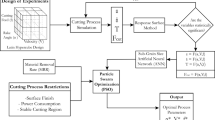Abstract
This work focuses on investigating the time dependence distribution of work-piece cutting temperature during milling process. The mathematical model of heat conduction problem has been obtained according to the basic characteristics of the milling process. A method of using weight particle swarm optimization (WPSO) to identify the heat flux has been established based on inverse heat conduction problem. Also, the distribution of cutting temperature of AISI1045 steel under the certain milling conditions has been studied by combining with the experimental data. Analysis results indicate that the global maximum and minimum heat flux are 2.856E6 and 2.823E6 W/(m2 °C), respectively, and the maximum fitness value of optimal position is 65.6385. Furthermore, the interfacial heat flux appears at three obvious non-linear stages, at the beginning of milling process there is a slow temperature rising platform period, and after this platform, the interface temperature between tool and work-piece rises rapidly, with a maximum temperature of about 860 °C. The maximum deviation between calculated and measured values is about 11.06 %. Results achieved in this paper show that the established method in this paper can be used to investigate the temperature distribution accurately during milling process.
Similar content being viewed by others
References
Yang K, Liang YC, Zheng KN, Bai QS, Chen WQ (2011) Tool edge radius effect on cutting temperature in micro end milling process. Int J Adv Manuf Technol 52:905–912
Ramesh MV, Seetharamu KN, Ganesan N, Kuppuswamy G (1999) Finite element modelling of heat transfer analysis in machining of isotropic materials. Int J Heat Mass Transf 42(9):1569–1583
Radulescu R, Kapoor SG (1994) An analytical model for prediction of tool temperature fields during continuous and interrupted cutting. Transactions of ASME. J Eng Ind 116:135–143
Lazoglu I, Altintas Y (2002) Prediction of tool and chip temperature in continuous and interrupted machining. Int J Mach Tools Manuf 42(9):1011–1022
Zhang SJ, Liu ZQ (2009) A new approach to cutting temperature prediction considering the diffusion layer in coated tools. Int J Mach Tools Manuf 49:619–624
Akbar F, Mativenga PT, Sheikh MA (2008) An investigation of the tool–chip interface temperature and heat partition in high-speed machining of AISI/SAE 4140 steel with TiN-coated tool. Proceedings of the 35th International MATADOR Conference 215–218
Haddag B, Kagnaya T, Nouari M, Cutard T (2013) A new heat transfer analysis in machining based on two steps of 3D finite element modelling and experimental validation. Heat Mass Transfer 49:129–145
Stephenson DA, Jen TC, Lavine AS (1997) Cutting tool temperatures in contour turning: transient analysis and experimental verification. Trans ASME 119:494–501
Brosse A, Naisson P, Hamdi H, Bergheau JM (2008) Temperature measurement and heat flux characterization in grinding using thermograph. J Mater Process Technol 201(1–3):590–595
Kim HJ, Kim NK, Kwak JS (2006) Heat flux distribution model by sequential algorithm of inverse heat transfer determining work-piece temperature in creep feed grinding. Int J Mach Tools Manuf 46:2086–2093
Norouzifard V, Hamedi M (2014) A three-dimensional heat conduction inverse procedure to investigate tool chip thermal interaction in machining process. Int J Adv Manuf Technol 74:1637–1648
Golbahar Haghighi MR, Eghtesad M, Malekzadeh P, Necsulescu DS (2008) Two-dimensional inverse heat transfer analysis of functionally graded materials in estimating time-dependent surface heat flux. Numer Heat Transfer A 54:744–762
AL-Mokhtar OM, Andrew W, Robert B (2012) Variable heat flux in numerical simulation of grinding temperatures. Int J Adv Manuf Technol 63:549–554
Gostimirovic M, Kovac P, Sekulic M (2011) An inverse heat transfer problem for optimization of the thermal process in machining. Indian Acad Sci 36(4):489–504
Wu JH, Liu ZQ (2010) Modeling of flow stress in orthogonal micro-cutting process based on strain gradient plasticity theory. Int J Adv Manuf Technol 46(1–4):143–149
Wang BS, Hao HY, Feng Y (2013) Identification of instantaneous cutting force coefficients using surface error. Int J Adv Manuf Technol 68(1–4):701–709
Shi Y, Eberhart RC (1998) A modified particle swarm optimizer. Proceedings of the IEEE Congress on Evolutionary Computation, Piscataway, NJ:69–73
Bi YB, Fang Q, Dong HY (2010) Research on 3D numerical simulation and experiment of cutting temperature for high speed milling of aerospace aluminum alloy. J Mech Eng 46(7):160–165 (in Chinese)
Johnson GR, Cook WH (1983) A constitutive model and data for metals subjected to large strains, high strain rates and high temperatures. The 7th International Symposium on Ballistics, Hague, Netherlands 541–547
Author information
Authors and Affiliations
Corresponding author
Rights and permissions
About this article
Cite this article
Feng, Y., Zheng, L., Wang, M. et al. Research on cutting temperature of work-piece in milling process based on WPSO. Int J Adv Manuf Technol 79, 427–435 (2015). https://doi.org/10.1007/s00170-015-6808-9
Received:
Accepted:
Published:
Issue Date:
DOI: https://doi.org/10.1007/s00170-015-6808-9




